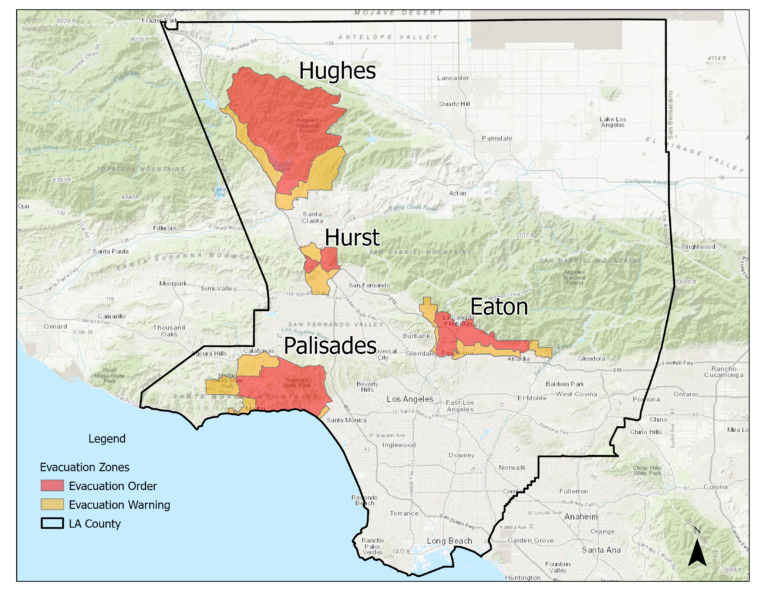A new data brief by UCLA researchers and AAPI Equity Alliance illustrates the significant language barriers facing Asian American communities, particularly those with limited English proficiency (LEP), who reside in fire evacuation zones during the Los Angeles wildfires.
These barriers can hinder access to critical emergency notifications, which are essential for timely evacuations and ensuring safety during wildfires, and crucial communication during the recovery and rebuilding process. In addition, reaching LEP Asian communities is especially challenging because they speak dozens of different languages.
AAPI Equity Alliance joins UCLA Asian American Studies Center, UCLA Center for Neighborhood Knowledge, and UCLA Latino Policy & Politics Institute in calling for improvements to language access for disaster communications.
Key Findings
Figure 4 highlights the locations of the four major fire evacuation zones in the county. The evacuation zones for the Palisades, Eaton, and Hurst fires are based on data as of January 8, 2025, while those for the Hughes fire are based on data as of January 23, 2025, as it started much later than the other three.
Figure 4. Fire Evacuation Zones: Eaton, Palisades, Hurst, and Hughes

Source: Map created by the authors using GIS shapefiles from Cal Fire for the Palisades, Eaton, and Hurst evacuation zones (as of January 8, 2025), the County of Los Angeles Emergency Map for the Hughes evacuation zone (as of January 23, 2025), and Census/TIGER/Line.
Finding 1: Nearly 50,000 Asian Americans reside within the evacuation zones, with over 12,000 needing language assistance due to limited English proficiency (LEP).
Nearly 50,000 Asian Americans live within the four major evacuation zones, making up 15% of the total population in these areas. The majority—close to 39,000 individuals—reside in the Eaton evacuation zone, where they account for nearly one-fifth (18%) of all residents. The proportion of Asian Americans varies across the other zones, as shown in Figure 5.
Figure 5: Estimated Number of Asian Americans in Fire Evacuation Zones
Over 12,000 Asian individuals aged 5 and older in the combined evacuation zones have limited English proficiency, representing over a quarter (26%) of the Asian population in these areas. However, LEP individuals are not evenly distributed across the evacuation zones. As illustrated in Figure 6, variations by location are evident: the Palisades zone has the highest proportion of LEP Asians, approaching 30%, while the Eaton zone also has a significant LEP population, with over a quarter of its Asian residents classified as LEP.
Figure 6: Percentage of Limited English Proficient Asian Americans in Fire Evacuation Zones
Finding 2: The most commonly spoken Asian languages in the combined evacuation zones are Chinese, Korean, Tagalog, and Vietnamese. However, dozens of other Asian languages are also represented and vary by evacuation zone.
Census data indicate that the most commonly spoken Asian languages in the combined evacuation zones are Chinese, Korean, Tagalog, and Vietnamese, as shown in Table 1. However, dozens of other Asian languages are also represented and vary by evacuation zone. Unfortunately, census-tract data on language are limited, as they only report on languages spoken by these four major Asian ethnic groups, consequently underreporting the linguistic diversity for all Asians. The available statistics fail to count the relatively smaller language groups, which are nonetheless still collectively sizeable.
Table 1. Language Spoken at Home for the Population Aged 5 and Older in Fire Evacuation Zones
School records on Asian English learners in elementary schools serving the evacuation zones provide additional insight into the broader range of language needs in these communities, identifying over a dozen different Asian languages spoken by students. Table 2 details the specific languages represented in these areas, including those reported with at least five elementary school students.
Table 2. Asian Languages Spoken by Limited English Proficient Elementary Students in Fire Evacuation Zones
Finding 3: Older Asian Americans experience significantly higher rates of LEP compared to younger generations, with LEP rates ranging from 15% among those aged 5 to 24 to 61% among those 65 and older.
In addition to ethnic differences, LEP rates also vary by age group, as shown in Figure 3. Older Asian Americans experience significantly higher rates of LEP compared to younger generations, with LEP rates ranging from 15% among those aged 5 to 24 to 61% among those 65 and older. This disparity is largely driven by generational differences, as younger Asian Americans are more likely to be U.S.-born and received education in the United States. Given these differences, outreach strategies during emergencies and recovery efforts should be tailored to meet the distinct needs of each age group, ensuring effective communication and support across generations.
Figure 3. Percentage of Limited English Proficient Asian Americans by Age Group in Los Angeles County
Recommendations
- Identify and Address Language Needs Proactively
- Conduct regular assessments to determine language assistance needs in fire evacuation zones.
- Use census, school data and community survey data to anticipate language barriers before disasters occur.
- Collaborate with researchers who have the necessary technical skills, expertise, and experience specific to Asian Americans communities to conduct detailed analyses.
- Ensure Culturally and Linguistically Appropriate Communication
- Provide in-language emergency materials tailored to the linguistic needs of each affected community.
- Move beyond a one-size-fits-all approach by recognizing the distinct languages spoken in different neighborhoods.
- Strengthen Partnerships with Community Organizations
- Collaborate with trusted, community-based organizations that serve limited-English proficient populations.
- Leverage these organizations’ existing relationships and expertise to improve outreach and emergency response.
- Establish Community Oversight and Engagement Mechanisms
- Create citizen oversight groups in the most affected communities, including community leaders who can advocate for LEP residents.
- Organize and facilitate local discussions with residents, using Asian language translators, to identify barriers in disaster recovery, rebuilding, and resettlement.
- Institutionalize Long-Term Improvements in Disaster Preparedness
- Implement multilingual alert systems and culturally relevant public service campaigns.
- Integrate language access planning into broader emergency response frameworks to ensure sustainability.
